Haoyang Huang
Chongqing University
Frame-Level Captions for Long Video Generation with Complex Multi Scenes
May 27, 2025Abstract:Generating long videos that can show complex stories, like movie scenes from scripts, has great promise and offers much more than short clips. However, current methods that use autoregression with diffusion models often struggle because their step-by-step process naturally leads to a serious error accumulation (drift). Also, many existing ways to make long videos focus on single, continuous scenes, making them less useful for stories with many events and changes. This paper introduces a new approach to solve these problems. First, we propose a novel way to annotate datasets at the frame-level, providing detailed text guidance needed for making complex, multi-scene long videos. This detailed guidance works with a Frame-Level Attention Mechanism to make sure text and video match precisely. A key feature is that each part (frame) within these windows can be guided by its own distinct text prompt. Our training uses Diffusion Forcing to provide the model with the ability to handle time flexibly. We tested our approach on difficult VBench 2.0 benchmarks ("Complex Plots" and "Complex Landscapes") based on the WanX2.1-T2V-1.3B model. The results show our method is better at following instructions in complex, changing scenes and creates high-quality long videos. We plan to share our dataset annotation methods and trained models with the research community. Project page: https://zgctroy.github.io/frame-level-captions .
Generative Pre-trained Autoregressive Diffusion Transformer
May 15, 2025Abstract:In this work, we present GPDiT, a Generative Pre-trained Autoregressive Diffusion Transformer that unifies the strengths of diffusion and autoregressive modeling for long-range video synthesis, within a continuous latent space. Instead of predicting discrete tokens, GPDiT autoregressively predicts future latent frames using a diffusion loss, enabling natural modeling of motion dynamics and semantic consistency across frames. This continuous autoregressive framework not only enhances generation quality but also endows the model with representation capabilities. Additionally, we introduce a lightweight causal attention variant and a parameter-free rotation-based time-conditioning mechanism, improving both the training and inference efficiency. Extensive experiments demonstrate that GPDiT achieves strong performance in video generation quality, video representation ability, and few-shot learning tasks, highlighting its potential as an effective framework for video modeling in continuous space.
STORYANCHORS: Generating Consistent Multi-Scene Story Frames for Long-Form Narratives
May 13, 2025Abstract:This paper introduces StoryAnchors, a unified framework for generating high-quality, multi-scene story frames with strong temporal consistency. The framework employs a bidirectional story generator that integrates both past and future contexts to ensure temporal consistency, character continuity, and smooth scene transitions throughout the narrative. Specific conditions are introduced to distinguish story frame generation from standard video synthesis, facilitating greater scene diversity and enhancing narrative richness. To further improve generation quality, StoryAnchors integrates Multi-Event Story Frame Labeling and Progressive Story Frame Training, enabling the model to capture both overarching narrative flow and event-level dynamics. This approach supports the creation of editable and expandable story frames, allowing for manual modifications and the generation of longer, more complex sequences. Extensive experiments show that StoryAnchors outperforms existing open-source models in key areas such as consistency, narrative coherence, and scene diversity. Its performance in narrative consistency and story richness is also on par with GPT-4o. Ultimately, StoryAnchors pushes the boundaries of story-driven frame generation, offering a scalable, flexible, and highly editable foundation for future research.
Step-Video-TI2V Technical Report: A State-of-the-Art Text-Driven Image-to-Video Generation Model
Mar 14, 2025Abstract:We present Step-Video-TI2V, a state-of-the-art text-driven image-to-video generation model with 30B parameters, capable of generating videos up to 102 frames based on both text and image inputs. We build Step-Video-TI2V-Eval as a new benchmark for the text-driven image-to-video task and compare Step-Video-TI2V with open-source and commercial TI2V engines using this dataset. Experimental results demonstrate the state-of-the-art performance of Step-Video-TI2V in the image-to-video generation task. Both Step-Video-TI2V and Step-Video-TI2V-Eval are available at https://github.com/stepfun-ai/Step-Video-TI2V.
Research and Implementation of Data Enhancement Techniques for Graph Neural Networks
Jun 18, 2024Abstract:Data, algorithms, and arithmetic power are the three foundational conditions for deep learning to be effective in the application domain. Data is the focus for developing deep learning algorithms. In practical engineering applications, some data are affected by the conditions under which more data cannot be obtained or the cost of obtaining data is too high, resulting in smaller data sets (generally several hundred to several thousand) and data sizes that are far smaller than the size of large data sets (tens of thousands). The above two methods are based on the original dataset to generate, in the case of insufficient data volume of the original data may not reflect all the real environment, such as the real environment of the light, silhouette and other information, if the amount of data is not enough, it is difficult to use a simple transformation or neural network generative model to generate the required data. The research in this paper firstly analyses the key points of the data enhancement technology of graph neural network, and at the same time introduces the composition foundation of graph neural network in depth, on the basis of which the data enhancement technology of graph neural network is optimized and analysed.
Language-Specific Neurons: The Key to Multilingual Capabilities in Large Language Models
Feb 26, 2024



Abstract:Large language models (LLMs) demonstrate remarkable multilingual capabilities without being pre-trained on specially curated multilingual parallel corpora. It remains a challenging problem to explain the underlying mechanisms by which LLMs process multilingual texts. In this paper, we delve into the composition of Transformer architectures in LLMs to pinpoint language-specific regions. Specially, we propose a novel detection method, language activation probability entropy (LAPE), to identify language-specific neurons within LLMs. Based on LAPE, we conduct comprehensive experiments on two representative LLMs, namely LLaMA-2 and BLOOM. Our findings indicate that LLMs' proficiency in processing a particular language is predominantly due to a small subset of neurons, primarily situated in the models' top and bottom layers. Furthermore, we showcase the feasibility to "steer" the output language of LLMs by selectively activating or deactivating language-specific neurons. Our research provides important evidence to the understanding and exploration of the multilingual capabilities of LLMs.
Synthetic Data (Almost) from Scratch: Generalized Instruction Tuning for Language Models
Feb 20, 2024Abstract:We introduce Generalized Instruction Tuning (called GLAN), a general and scalable method for instruction tuning of Large Language Models (LLMs). Unlike prior work that relies on seed examples or existing datasets to construct instruction tuning data, GLAN exclusively utilizes a pre-curated taxonomy of human knowledge and capabilities as input and generates large-scale synthetic instruction data across all disciplines. Specifically, inspired by the systematic structure in human education system, we build the taxonomy by decomposing human knowledge and capabilities to various fields, sub-fields and ultimately, distinct disciplines semi-automatically, facilitated by LLMs. Subsequently, we generate a comprehensive list of subjects for every discipline and proceed to design a syllabus tailored to each subject, again utilizing LLMs. With the fine-grained key concepts detailed in every class session of the syllabus, we are able to generate diverse instructions with a broad coverage across the entire spectrum of human knowledge and skills. Extensive experiments on large language models (e.g., Mistral) demonstrate that GLAN excels in multiple dimensions from mathematical reasoning, coding, academic exams, logical reasoning to general instruction following without using task-specific training data of these tasks. In addition, GLAN allows for easy customization and new fields or skills can be added by simply incorporating a new node into our taxonomy.
Not All Metrics Are Guilty: Improving NLG Evaluation with LLM Paraphrasing
May 24, 2023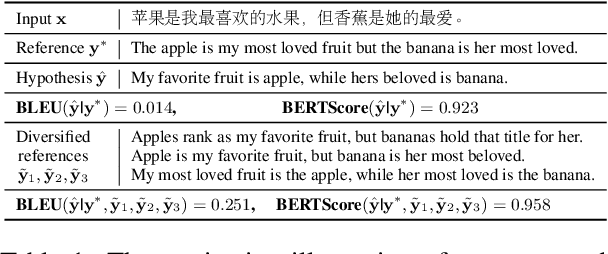
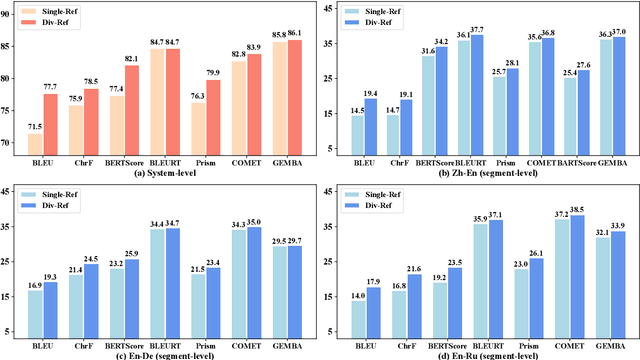

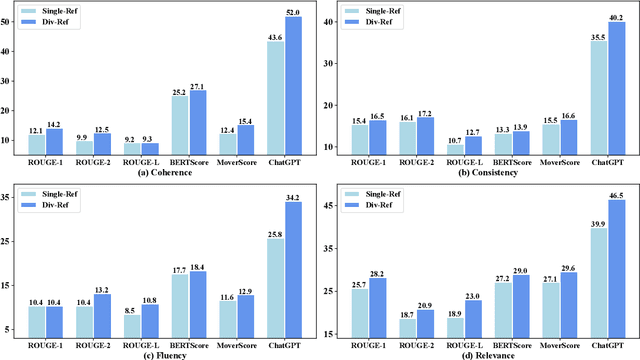
Abstract:Most research about natural language generation (NLG) relies on evaluation benchmarks with limited references for a sample, which may result in poor correlations with human judgements. The underlying reason is that one semantic meaning can actually be expressed in different forms, and the evaluation with a single or few references may not accurately reflect the quality of the model's hypotheses. To address this issue, this paper presents a novel method, named Para-Ref, to enhance existing evaluation benchmarks by enriching the number of references. We leverage large language models (LLMs) to paraphrase a single reference into multiple high-quality ones in diverse expressions. Experimental results on representative NLG tasks of machine translation, text summarization, and image caption demonstrate that our method can effectively improve the correlation with human evaluation for sixteen automatic evaluation metrics by +7.82% in ratio. We release the code and data at https://github.com/RUCAIBox/Para-Ref.
One-stop Training of Multiple Capacity Models
May 24, 2023



Abstract:Training models with varying capacities can be advantageous for deploying them in different scenarios. While high-capacity models offer better performance, low-capacity models require fewer computing resources for training and inference. In this work, we propose a novel one-stop training framework to jointly train high-capacity and low-capactiy models. This framework consists of two composite model architectures and a joint training algorithm called Two-Stage Joint-Training (TSJT). Unlike knowledge distillation, where multiple capacity models are trained from scratch separately, our approach integrates supervisions from different capacity models simultaneously, leading to faster and more efficient convergence. Extensive experiments on the multilingual machine translation benchmark WMT10 show that our method outperforms low-capacity baseline models and achieves comparable or better performance on high-capacity models. Notably, the analysis demonstrates that our method significantly influences the initial training process, leading to more efficient convergence and superior solutions.
Chain-of-Dictionary Prompting Elicits Translation in Large Language Models
May 24, 2023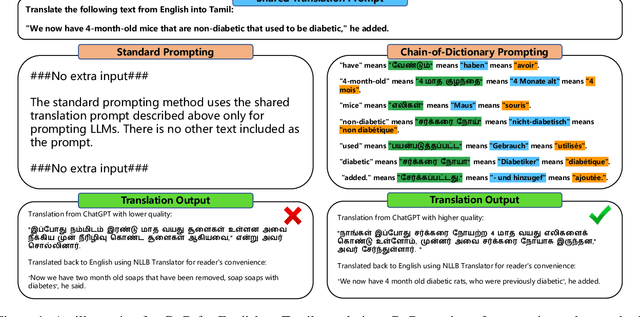


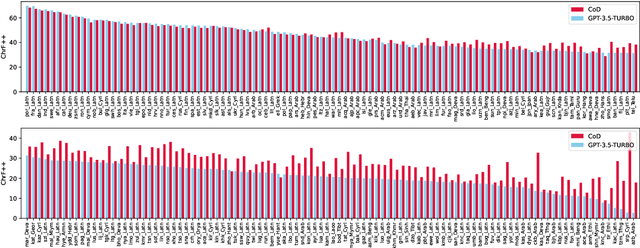
Abstract:Large language models (LLMs) have shown surprisingly good performance in multilingual neural machine translation (MNMT) even when trained without parallel data. Yet, despite the fact that the amount of training data is gigantic, they still struggle with translating rare words, particularly for low-resource languages. Even worse, it is usually unrealistic to retrieve relevant demonstrations for in-context learning with low-resource languages on LLMs, which restricts the practical use of LLMs for translation -- how should we mitigate this problem? To this end, we present a novel method, CoD, which augments LLMs with prior knowledge with the chains of multilingual dictionaries for a subset of input words to elicit translation abilities for LLMs. Extensive experiments indicate that augmenting ChatGPT with CoD elicits large gains by up to 13x chrF++ points for MNMT (3.08 to 42.63 for English to Serbian written in Cyrillic script) on FLORES-200 full devtest set. We further demonstrate the importance of chaining the multilingual dictionaries, as well as the superiority of CoD to few-shot demonstration for low-resource languages.
 Add to Chrome
Add to Chrome Add to Firefox
Add to Firefox Add to Edge
Add to Edge